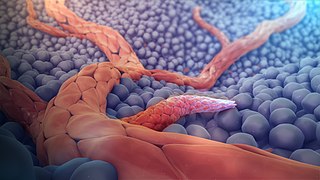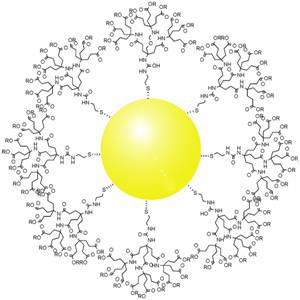Related Research Articles

Angiogenesis is the physiological process through which new blood vessels form from pre-existing vessels, formed in the earlier stage of vasculogenesis. Angiogenesis continues the growth of the vasculature by processes of sprouting and splitting. Vasculogenesis is the embryonic formation of endothelial cells from mesoderm cell precursors, and from neovascularization, although discussions are not always precise. The first vessels in the developing embryo form through vasculogenesis, after which angiogenesis is responsible for most, if not all, blood vessel growth during development and in disease.
An angiogenesis inhibitor is a substance that inhibits the growth of new blood vessels (angiogenesis). Some angiogenesis inhibitors are endogenous and a normal part of the body's control and others are obtained exogenously through pharmaceutical drugs or diet.

Endostatin is a naturally occurring, 20-kDa C-terminal fragment derived from type XVIII collagen. It is reported to serve as an anti-angiogenic agent, similar to angiostatin and thrombospondin.

Nitroxoline is an antibiotic that has been in use in Europe for about fifty years, and has proven to be very effective at combating biofilm infections. Nitroxoline was shown to cause a decrease in the biofilm density of P. aeruginosa infections, which would allow access to the infection by the immune system in vivo. It was shown that nitroxoline functions by chelating Fe2+ and Zn2+ ions from the biofilm matrix; when Fe2+ and Zn2+ were reintroduced into the system, biofilm formation was reconstituted. The activity of biofilm degradation is comparable to EDTA, but has a history of human use in clinical settings and therefore has a precedent with which to allow its use against “slimy” biofilm infections.

72 kDa type IV collagenase also known as matrix metalloproteinase-2 (MMP-2) and gelatinase A is an enzyme that in humans is encoded by the MMP2 gene. The MMP2 gene is located on chromosome 16 at position 12.2.

Atiprimod is a substance being studied in the treatment of certain multiple myelomas and other advanced cancers. It may block the growth of tumors and the growth of blood vessels from surrounding tissue to the tumor. This drug is also being researched as a potential treatment for various autoimmune diseases. It was first developed by GlaxoSmithKline as a potential treatment for rheumatoid arthritis. The substance is also known as azaspirane, although this more properly refers to the class of chemicals to which atiprimod belongs.
The term nanocell refers to a drug delivery platform consisting of a polymer-bound chemotherapeutic drug combined with a lipid-bound anti-angiogenesis drug. Nanocells are currently being developed in the lab of Shiladitya Sengupta of MIT.
Angiogenesis is the process of forming new blood vessels from existing blood vessels. It is a highly complex process involving extensive interplay between cells, soluble factors, and the extracellular matrix (ECM). Angiogenesis is critical during normal physiological development, but it also occurs in adults during inflammation, wound healing, ischemia, and in pathological conditions such as rheumatoid arthritis, hemangioma, and tumor growth. Proteolysis has been indicated as one of the first and most sustained activities involved in the formation of new blood vessels. Numerous proteases including matrix metalloproteases (MMPs), a disintegrin and metalloprotease domain (ADAM), a disintegrin and metalloprotease domain with throbospondin motifs (ADAMTS), and cysteine and serine proteases are involved in angiogenesis. This article focuses on the important and diverse roles that these proteases play in the regulation of angiogenesis.

The hallmarks of cancer comprise six biological capabilities acquired during the multistep development of human tumors. The hallmarks constitute an organizing principle for rationalizing the complexities of neoplastic disease. They include sustaining proliferative signaling, evading growth suppressors, resisting cell death, enabling replicative immortality, inducing angiogenesis, and activating invasion and metastasis. Underlying these hallmarks are genome instability, which generates the genetic diversity that expedites their acquisition, and inflammation, which fosters multiple hallmark functions. Conceptual progress in the last decade has added two emerging hallmarks of potential generality to this list—reprogramming of energy metabolism and evading immune destruction. In addition to cancer cells, tumors exhibit another dimension of complexity: they contain a repertoire of recruited, ostensibly normal cells that contribute to the acquisition of hallmark traits by creating the “tumor microenvironment.” Recognition of the widespread applicability of these concepts will increasingly affect the development of new means to treat human cancer.

NAMI-A and KP1019 are two ruthenium anticancer agents that have entered clinical trials. Contrary to what can be found in some papers, "the nickname NAMI is not the acronym of “New Anticancer Metastasis Inhibitor”, but has a much more prosaic origin. It was created by a student as a short-form name of the chemical formula of the complex: “NA” comes from the symbol for sodium and “MI” from the word imidazole. The corresponding imidazolium salt was simply called NAMI-A to signify that it was an upgraded version of the prototype NAMI".

Withaferin A is a steroidal lactone, derived from Acnistus arborescens, Withania somnifera and other members of family Solanaceae. It has been traditionally used in ayurvedic medicine. It is the first member of the withanolide class of ergostane type product to be discovered. This natural product has wide range of pharmacological activities including cardioprotective, anti-inflammatory, immuno-modulatory, anti-angiogenesis, anti-metastasis and anti-carcinogenic properties.

mTOR inhibitors are a class of drugs that inhibit the mammalian target of rapamycin (mTOR), which is a serine/threonine-specific protein kinase that belongs to the family of phosphatidylinositol-3 kinase (PI3K) related kinases (PIKKs). mTOR regulates cellular metabolism, growth, and proliferation by forming and signaling through two protein complexes, mTORC1 and mTORC2. The most established mTOR inhibitors are so-called rapalogs, which have shown tumor responses in clinical trials against various tumor types.
Tumor-associated macrophages (TAMs) are a class of immune cells present in high numbers in the microenvironment of solid tumors. They are heavily involved in cancer-related inflammation. Macrophages are known to originate from bone marrow-derived blood monocytes or yolk sac progenitors, but the exact origin of TAMs in human tumors remains to be elucidated. The composition of monocyte-derived macrophages and tissue-resident macrophages in the tumor microenvironment depends on the tumor type, stage, size, and location, thus it has been proposed that TAM identity and heterogeneity is the outcome of interactions between tumor-derived, tissue-specific, and developmental signals.

Immunomodulatory imide drugs (IMiDs) are a class of immunomodulatory drugs containing an imide group. The IMiD class includes thalidomide and its analogues. These drugs may also be referred to as 'Cereblon modulators'. Cereblon is the protein targeted by this class of drugs.

Gold nanoparticles in chemotherapy and radiotherapy is the use of colloidal gold in therapeutic treatments, often for cancer or arthritis. Gold nanoparticle technology shows promise in the advancement of cancer treatments. Some of the properties that gold nanoparticles possess, such as small size, non-toxicity and non-immunogenicity make these molecules useful candidates for targeted drug delivery systems. With tumor-targeting delivery vectors becoming smaller, the ability to by-pass the natural barriers and obstacles of the body becomes more probable. To increase specificity and likelihood of drug delivery, tumor specific ligands may be grafted onto the particles along with the chemotherapeutic drug molecules, to allow these molecules to circulate throughout the tumor without being redistributed into the body.

Tumor-associated endothelial cells or tumor endothelial cells (TECs) refers to cells lining the tumor-associated blood vessels that control the passage of nutrients into surrounding tumor tissue. Across different cancer types, tumor-associated blood vessels have been discovered to differ significantly from normal blood vessels in morphology, gene expression, and functionality in ways that promote cancer progression. There has been notable interest in developing cancer therapeutics that capitalize on these abnormalities of the tumor-associated endothelium to destroy tumors.
VEGFR-2 inhibitor, also known as kinase insert domain receptor(KDR) inhibitor, are tyrosine kinase receptor inhibitors that reduce angiogenesis or lymphangiogenesis, leading to anticancer activity. Generally they are small, synthesised molecules that bind competitively to the ATP-site of the tyrosine kinase domain. VEGFR-2 selective inhibitor can interrupt multiple signaling pathways involved in tumor, including proliferation, metastasis and angiogenesis.
The host response to cancer therapy is defined as a physiological response of the non-malignant cells of the body to a specific cancer therapy. The response is therapy-specific, occurring independently of cancer type or stage.

Michele 'Miki' De Palma is an Italian biologist and a Professor at EPFL. He is known for his work on the role of macrophages in cancer progression and the discovery of Tie2-expressing angiogenic monocytes.
Adriana Albini is an Italian pathologist and cancer researcher. She developed the concept of angioprevention which can be used to control cancer development. She is a competitive fencer and six of her novels have been published. In 2000 she was the Scientific Director at the Fondazione MultiMedica Onlus in Milan.
References
- ↑ Bisacchi, D; Benelli, R; Vanzetto, C; Ferrari, N; Tosetti, F; Albini, A (2003-01-01). "Anti-angiogenesis and angioprevention: mechanisms, problems and perspectives". Cancer Detection and Prevention. 27 (3): 229–238. doi:10.1016/S0361-090X(03)00030-8. ISSN 0361-090X.
- ↑ Tosetti F, Ferrari N, De Flora S, Albini A. Angioprevention': angiogenesis is a common and key target for cancer chemopreventive agents.FASEB J. 2002 Jan;16(1):2-14.
- ↑ Albini A, Indraccolo S, Noonan DM, Pfeffer U. Functional genomics of endothelial cells treated with anti-angiogenic or angiopreventive drugs.Clin Exp Metastasis. 2010 Aug;27(6):419-39
- ↑ Alkhabuli, Juma O. (2007-03-01). "Significance of neo-angiogenesis and immuno-surveillance cells in squamous cell carcinoma of the tongue". The Libyan Journal of Medicine. 2 (1): 30–39. doi:10.4176/070110. ISSN 1993-2820. PMC 3078233 . PMID 21503229.